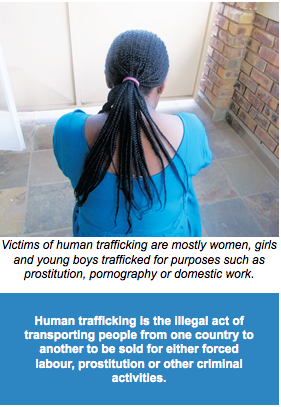Every year, thousands of people are trafficked into South Africa and sold into forced labour or prostitution. This is seen as slavery. Several government departments are presently working together on a massive awareness campaign to stop this social evil.
 Human trafficking is driven by networks situated in source countries with links to South Africa as destination. Perpetrators and intermediaries include large organised-crime networks.
Human trafficking is driven by networks situated in source countries with links to South Africa as destination. Perpetrators and intermediaries include large organised-crime networks.
Government departments, including Social Development, Justice and Constitutional Development, Home Affairs, Police, the National Prosecuting Authority and the Women, Children and People with Disabilities are working with non-governmental organisations to fight human trafficking. These include the International Organisation for Migration (IOM).
False job offers
The victims of human trafficking are normally forced to work as slaves in foreign countries. These people accept attractive job offers in other countries without knowing that these offers are false.
When they arrive in the countries where the jobs are said to be, they are forced into prostitution or labour with little or no pay. The people who get money are the traffickers or the people who brought them to those countries under false promises.
Women, children and boys
Women victims of human trafficking are usually violently abused and made to repay large sums of money to their traffickers, according the Justice Department. Their travel documents like passports are taken away from them so that they cannot escape.
Because of economic opportunities, South Africa is the destination of choice for most human traffickers. Victims of human trafficking are mostly women, girls and boys trafficked for a variety of reasons including prostitution, pornography or domestic work. Young boys are also used to smuggle drugs and for other criminal activities.
Routes
People are mainly trafficked into South Africa from Thailand, the Philippines, India, China, Bulgaria, Romania, Russia and the Ukraine. Within Africa, they are mostly from Mozambique, Zimbabwe, Malawi, Swaziland and Lesotho, but also from the Democratic Republic of Congo (DRC), Angola, Rwanda, Kenya, Cameroon, Nigeria and Somalia.
Measures that government has put into place include the Prevention and Combating of Trafficking in Persons Act.
During the 2010 FIFA World Cup, government, through the Department of Home Affairs, took steps to protect victims of human trafficking and arrest the perpetrators.
Places of safety
Victims of human trafficking are placed in places of safety to help them lead normal lives. They are asked to give information, if they are willing to do so, to help track down and take steps against perpetrators. With the help of embassies, steps are also taken to return foreign nationals who are victims of trafficking safely to their countries.



 Facebook
Facebook Twitter
Twitter WhatsApp
WhatsApp